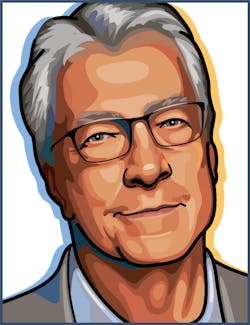China’s Belt and Road Initiative presents serious challenges and opportunities for photonics companies

When speaking at our recent Lasers & Photonics Marketplace Seminar, at my request Dr. Bo Gu spent considerable time describing to the audience what China’s Belt and Road Initiative (previously called One Belt, One Road) is and what it might mean for them. Afterward I was struck by the numerous comments and thanks for the information that surprised many of the executives in the audience. The Belt and Road Initiative is a sweeping, long-term plan by the Chinese government that will have many implications for international relations, global trade, manufacturing, the environment, and, yes, photonics.
The Belt and Road (B&R) Initiative, or One Belt, One Road (OBOR), is a development strategy and framework proposed by Chinese leader Xi Jinping in 2013 that focuses on connectivity and cooperation among the People's Republic of China and the rest of Eurasia. It consists of two main components, the land-based Silk Road Economic Belt (SREB) and oceangoing Maritime Silk Road (MSR).
I’ve provide some resources below to help you explore more, but this text by Ambassador Chas Freeman serves as a good introduction:
“The “one belt, one road” initiative is partly a short-term measure to alleviate overcapacity in China’s cement, steel and aluminum industries by conjuring up export markets for them. It will let Chinese manufacturing and construction companies continue for a while to do the sort of work abroad that is winding down at home. The initiative is also a way of developing Xinjiang and other parts of western China by making them key connectors to Europe and the Middle East through Central Asia and Russia.
But, in the longer term, “one belt, one road” is a strategy to use Chinese resources to tie Europe and Asia more closely to each other and to China. The added efficiencies of its planned railways, waterways, highways, pipelines, power grids, fiber optic cables, and air and sea ports respond to real market requirements and opportunities. Its institutional linkages will facilitate the investment necessary to realize these efficiencies.”
The B&R requires cooperation among over 70 countries in areas such as transportation, advanced manufacturing, infrastructure, and energy and natural resources—all areas where photonics technologies play crucial roles. European countries led by Germany ($4.5B) have made substantial contributions to the Asian Infrastructure Investment Bank’s $100 billion initial capital funding for B&R. China ($29.8B), India ($8.4B), and Russia ($6.5B) have contributed the largest sums. So far these funds have gone toward hydropower plants, high-speed railways, and upgraded shipping ports and airports.
In his Seminar talk, Dr. Gu saw many opportunities for lasers to play a role, and for advanced manufacturing technologies such as Industry 4.0 to help solve problems of resource limitations and environmental pollution. Germany in particular stands to benefit from this vast market for technological products and services—but Germany is far from alone.
There are many useful resources available via a Google Search regarding B&R, but here are a few I found most interesting:
For a European perspective on B&R/OBOR and its impact:
MERICS--The Mercator Institute for China Studies, in Berlin, has an excellent series of reports and meetings on the impact of B&R/OBOR on Europe.
For an American perspective on B&R/OBOR, two articles by former ambassadors:
China and the US: Two Visions, One Collaboration? By Ambassador Marc Grossman at The Cohen Group
“One Belt, One Road:” What’s in It For Us? By Ambassador Chas Freeman at Brown University’s Watson Institute for International and Public Affairs
For China’s official and interesting government website on B&R/OBOR:
I'll be following B&R developments in China and across Asia in the coming months. Later this month, I'll also report on the view from LASER World of Photonics China, in Shanghai, March 14-16.
About the Author

Conard Holton
Conard Holton has 25 years of science and technology editing and writing experience. He was formerly a staff member and consultant for government agencies such as the New York State Energy Research and Development Authority and the International Atomic Energy Agency, and engineering companies such as Bechtel. He joined Laser Focus World in 1997 as senior editor, becoming editor in chief of WDM Solutions, which he founded in 1999. In 2003 he joined Vision Systems Design as editor in chief, while continuing as contributing editor at Laser Focus World. Conard became editor in chief of Laser Focus World in August 2011, a role in which he served through August 2018. He then served as Editor at Large for Laser Focus World and Co-Chair of the Lasers & Photonics Marketplace Seminar from August 2018 through January 2022. He received his B.A. from the University of Pennsylvania, with additional studies at the Colorado School of Mines and Medill School of Journalism at Northwestern University.